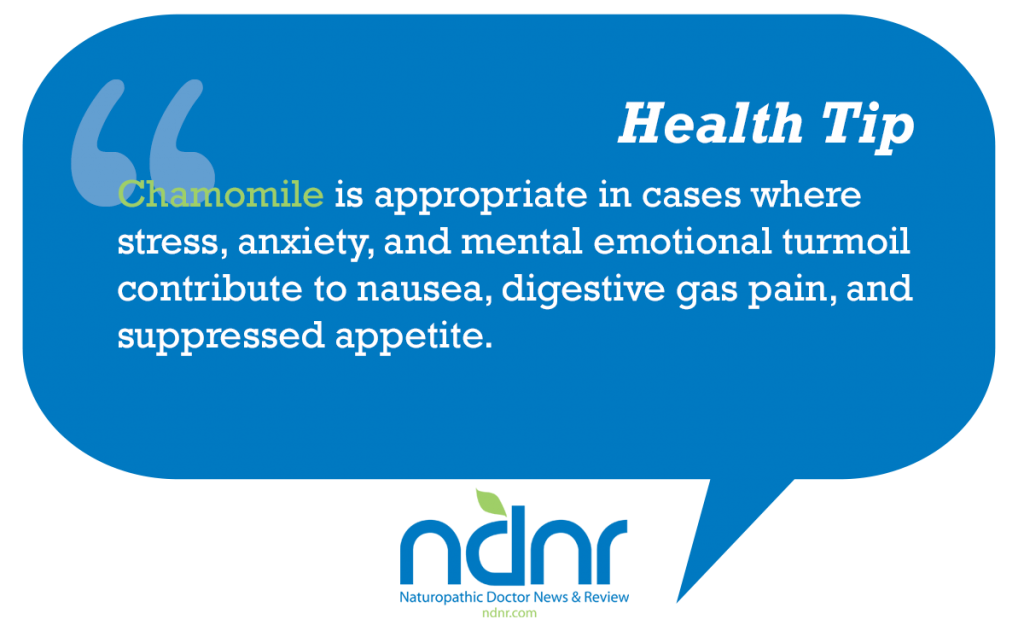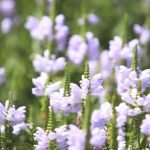Materia Medica Review for Gastrointestinal Inflammation
Clinical Pearls for Pain
Jillian Stansbury, ND
Irritable bowel, food intolerances, stress-related digestive disorders, ulcerative pathologies, and infectious and dysbiotic gastrointestinal complaints are among the most common of all patient complaints in general family practice. The acute pain, nausea or bloating, and discomfort occurring with many of these conditions will respond well to herbal therapies, especially teas because direct surface contact is possible, helping demulcents, antimicrobials, and anti-inflammatories to have significant local effects. Herbal therapies can also improve cancer, nociceptive pain, and neuralgia due to systemic effects. Pain and discomfort owing to vascular congestion can often be alleviated with “blood movers” and vascular tonics. Specific herbs may improve vascular inflammation and congestion due to diabetes, diverticuli, and varicosities, as well as with liver failure, portal congestion, highly vascular carcinomas, and other serious pathologies.
Following is a simple materia medica review to help guide clinicians in putting together effective herbal formulas for such complaints. My goal here is not to present the research or the proposed biochemical mechanisms of action but rather to offer a user-friendly guide based on my own clinical experience.
Achillea millefolium
Yarrow may affect the peripheral vascular system as both a styptic and a vascular decongestant, reducing pain due to vascular stasis and congestion. Achillea also has antispasmodic and anti-inflammatory properties, making it useful for pain and a variety of pelvic conditions. Especially consider Achillea when watery diarrhea and blood in the stool are present.
Aesculus hippocastanum
Horse chestnut is an astringent, particularly to the blood vessels, and is indicated for liver congestion, portal congestion, varicosities, and long-standing alcoholism or liver burden. Aesculus has a long history of medicinal use as a venous tonic. Escin from Aesculus seeds has anti-inflammatory and antiedema capabilities, as well as an ability to reduce capillary permeability. Escin also promotes contractility of venous wall elastin fibers, preventing venous dilation. Felter lists Aesculus as specific for a sense of constipation or tightness in the rectum. Consider it as an ingredient in complex formulas for pain due to highly vascular and congested digestive cancers.
Althea
Do not forget the significant pain relief that thick mucilaginous herbal teas such as mallow and slippery elm can provide. The trick is to allow the Althea or Ulmus to soak for several hours or overnight if possible and then bring to a very gentle simmer for only several minutes. Let it stand covered for 30 minutes, strain, and drink at least 2 or 3 cups for acute ulcerative and irritative pain in the stomach and intestinal pain, reflux, and diarrhea.
Ananas comosus
Pineapple fruit contains a mixture of sulphur-containing proteolytic enzymes known as bromelain. Bromelain and the consumption of whole pineapple have an anti-inflammatory effect on the bowels and can deter pinworms and other intestinal parasites. Eat a whole fresh pineapple per day, while avoiding sugar and flour, as a gentle amebacide and worm remedy. Bromelain encapsulation can promote healing and prevent postsurgical bruising and hematomas for patients undergoing abdominal surgery.
Angelica sinensis
Dong quai is a blood mover with vasodilatory effects on the pelvic vasculature that can improve perfusion to abdominal organs and reduce congestion in the pelvis and vasculature in general. Angelica also has broad anti-inflammatory and antiallergy effects, making it appropriate to include in formulas for food allergies, gluten enteropathy, systemic allergic disorders, and pathologies related to age on inflammation in the blood vessels.
Apium graveolens
Celery seeds have a long history of use as a sedative and an anti-inflammatory for gout and arthritis but are often overlooked for gastrointestinal complaints. Apium decoctions and tinctures can be effective as simple carminatives, and most Apiaceae family members have antiallergy and anti-inflammatory effects, while being nutritive and rich in minerals.
Atropa belladonna
Deadly nightshade contains a tropane alkaloid known as atropine that is a strong spasmolytic and may be used internally in minute dosages for cramps and muscular spasms as seen with some cases of “spastic colon.” An appropriate dose is 5 to 10 mL in a 60-mL formula because Atropa belladonna is potentially toxic. Belladonna teas may also be applied topically over the abdomen for severe intestinal cramping, with the awareness that it can be absorbed systemically by this method.
Bupleurum falcatum
Bupleurum falcatum has an anti-inflammatory effect to internal organs, including the liver, kidneys, and spleen. Bupleurum has been used in Traditional Chinese Medicine to help the liver “smooth the qi.” Consider Bupleurum in formulas for hepatitis, cholecystitis, and gastritis.
Calendula officinalis
The pot marigold is well known for use in salves and skin preparations, but it is sometimes overlooked for its effects on healing intestinal mucosa. Include Calendula in teas for ulcers, gastritis, and formulas for recovering from intestinal infections.
Centella asiatica
Centella asiatica contains anti-inflammatory triterpenoids and has been used for centuries in India as a wound healing agent. Include Centella in formulas for peptic and intestinal ulcers and for patients undergoing surgical procedures to promote healing.
Cinnamomum
Cinnamon is known to be blood moving and blood glucose regulating and is used to inhibit excessive platelet aggregation in situations of inflammatory activation in blood cells. Cinnamon is appropriate in formulas for patients with diabetes and patients with metabolic syndrome.
Collinsonia
Stone root is indicated for venous stasis and sluggish circulation and dilated capillaries, with muscular atony. Collinsonia has activity in the oral, rectal, and urinary mucosa and is indicated in patients having irritation with atony. It may be used for varicosities, including labial varicosities, hemorrhoids, and varicose veins. Collinsonia is specific for a sense of constriction in the throat, larynx, and pharynx, as well as a tickling sensation and symptoms due to overuse of the voice and may be included in a variety of esophageal formulas for varices, congestions, and chronic mucus. For this complaint, use an aromatic syrup of Collinsonia to help it cling to the throat as long as possible. Collinsonia is also specific for a sense of constriction in other tissues such as hemorrhoids, the sense of splinters and sticking pains of a sensation of foreign body in the anus and venous stasis and congestion in the pelvis, and a sense of engorgement that results in tenesmus of the bladder or rectum and venous congestion in the lower limbs.
Curcuma longa
Turmeric can be a supportive herb in formulas for liver pain and discomfort related to inflammation and infection. Turmeric can be useful before surgery and may be combined with bromelain for all serious injuries and procedures to decrease pain, speed healing, and reduce the formation of adhesions.
Dioscorea villosa
Wild yam is usually highly effective for crampy pain in hollow organs and is appropriate to include in formulas for biliary colic, intestinal spasm, and general gas, bloating, and cramping in the bowels. It is effective in both tea and tincture forms. Dioscorea with Mentha and Matricaria is a good base formula for infants with colic.
Gelsemium sempervirens
Yellow jasmine is a strong botanical with a great potential for toxicity and is typically used in drop or diluted dosages. Gelsemium can be included in small amounts in formulas for acute intestinal infections. Gelsemium has been used for malarial fevers or other fevers associated with nervous irritation. Where there is flushing, fever, spinal irritation, twitching, and restlessness, Gelsemium is considered specific. Gelsemium is indicated in cases of fever, flushing, and restlessness. Use only several milliliters in a 2-oz tincture formula.
Glycyrrhiza glabra
Licorice is anti-inflammatory systemically, as well as locally within the gastrointestinal tract, where it is helpful to reduce the inflammation of ulcerative conditions and colitis. Some phytosteroidal constituents in licorice are thought to potentiate the action of cortisol, serving to decrease inflammation naturally or help reduce the dosage of and wean from corticosteroids. Include it in teas for diarrhea, infections, and digestive ulcers.
Hamamelis virginiana
Witch hazel is indicated for venous congestion and engorgement in which the tissues become full and relaxed and the veins become prominent. It may be used both topically and internally for circulatory pathologies, where it acts as an astringent and a venous tonic. Hamamelis may help correct engorgement and swelling in tissues, especially veins, hemorrhoids, and prolapsed rectal and uterine tissues, as well as sore throats and chronic coat on the tongue. Hamamelis is also used for gastrointestinal weakness when there is blood and mucus in the stool. As a venous tonic, Hamamelis is reported to act on vein walls, reducing varicosities and laxity of venous tone. Hamamelis is specific for pale relaxed tissues, with engorged bulging veins, and for a sense of weight and engorgement.
Humulus lupulus
Hops are calming to the nervous system and antispasmodic to the muscles and stomach and intestines. Hops are particularly useful for gas and intestinal cramps due to low stomach acidity and for pain, spasm, or tremors accompanied by nervousness and anxiety. They can also be used topically in “hops bags” over the abdomen for the pain. Place them in a muslin or other bag, and slightly moisten it with hot steamy water.
Hypericum perforatum
Saint-John’s-wort is high in hypericin, a bright red flavonoid credited with anti-inflammatory effects for nerves and connective tissue. Because venous wall integrity is dependent on flavonols, Hypericum and other sources of bioflavonoids are useful in treating varicosities. Bioflavonoids serve to reduce vascular fragility and enhance venous muscle tone. Consider Hypericum in formulas for autoimmune vasculitis and connective tissue disorders. Also consider Hypericum where there is neuralgia due to the bulk of tumors or when neuritis due to cellular inflammation and destruction accompanies cancer or other pathologies.
Matricaria chamomilla
Chamomile flowers can be highly effective for intestinal pain, nausea, and the discomfort of severe bloating and distension in the stomach and intestines. Teas are usually the most effective compared with tinctures or capsules. Because of additional nervine effects, Matricaria is appropriate in cases where stress, anxiety, and mental emotional turmoil contribute to nausea, digestive gas and pain, and suppressed appetite. It is a gentle bitter with a more palatable flavor than the leading alteratives for children with colic, toddlers with tummy aches, and teens in need of a gentle nervous and digestive alterative.
Mentha piperita
Peppermint is an antispasmodic to the digestive organs and can be a fast-acting anodyne for intestinal cramps and uncomfortable gas and bloating. Peppermint essential oil can be used topically for intestinal cramps and in infants with colic. Peppermint oil may also diminish acute gallbladder colic when ingested orally and applied topically and can aid in the dissolution of gallstones if used long term. Peppermint tea, and even smelling peppermint essential oil, is one of best tools for allaying nausea whether due to flu and infection, motion and car sickness, or an adverse effect of chemotherapy. Mint tincture or essential oil added to demulcent tinctures may help improve esophageal pain, globus hystericus, and esophageal spasms.
Petasites hybridus
Butterbur is traditional for lung pain, headaches, and upper respiratory inflammation. Petasites may also help allay nociceptive pain in patients with digestive organ cancer and metastatic lesions. Use frequent larger doses of encapsulations and include it in teas and tinctures. It may be used long term for several months, with 24-hour to 48-hour breaks.
Piscidia erythrina
Jamaican dogwood is anti-inflammatory and antispasmodic and is used as a general anodyne. Piscidia is especially indicated in the case of muscle spasm such as persistent hiccups, intestinal spasm, and stress-related digestive upset with body tension.
Silybum marianum
Nociceptive pain in patients with cancer and liver and renal masses may respond to milk thistle–containing therapies. Use larger and frequent dosing in capsules, teas, and tinctures. Silybum may improve digestive pain due to direct effects on the hepatocytes and general anti-inflammatory effects.
Tanacetum parthenium
Consider feverfew for irritable bowel syndrome and digestive inflammation in patients with concomitant migraines and systemic allergies. Tanacetum is appropriate in formulas when bowel reactivity with easy diarrhea is suspected to be allergic and to help reduce systemic allergic symptoms in patients with suspected leaky gut. Like its cousin Petasites, Tanacetum may also improve pain when used in formulas for digestive cancers. Feverfew may inhibit the release of serotonin, histamine, and other cytokines, improving general vascular and cellular inflammation and spasm.
Ulmus fulva
Slippery elm gruel, which I rename “porridge” for my patients, is a classic therapy to allay acute ulcerative and peptic pain but is one that many physicians seem not to bother with. Let this be a brief word of encouragement as to how effective it can be and how actually very simple it is to prepare. Tinctures and Ulmus encapsulations may pale in their anodyne effects compared with ingesting several cups full of slippery elm porridge. Place a cup of light fluffy powder in the bottom of a cereal bowl, with a few pieces of minced dried and fresh fruit if the patient can tolerate them because this can sweeten the mixture. Cover it with a cup of cool water, and whisk it into a sticky paste. Let it sit 1 hour or longer. Thin it down with any combination of Matricaria, Foeniculum, and Glycyrrhiza teas. Whisk it vigorously with a fork, while adding hot tea to achieve the desirable consistency. Eat as much as possible, and follow it with additional herbal tea.
Vaccinium myrtillus
Bilberry will not improve pain acutely, but all red, blue, and purple fruits and juices may improve vascular integrity over time and may reduce intestinal bleeding and support connective tissues when cancer, ulcers, and other digestive lesions are present. Vaccinium is considered to be safe with pharmaceuticals or for use before and after undergoing chemotherapy, reduces inflammation due to leaky endothelium, and strengthens connective tissues. Bilberry improves microcirculation. Anthocyanosides are credited with these actions.
Zingiber officinale
Ginger is especially indicated for cold symptoms and pain due to insufficient heat and blood in the digestive organs and weak secretions and digestion. Ginger is well known to settle nausea and help relieve bloating, distensive pain, and intestinal cramping. Tinctures and even quality candied ginger are easy to pack for those sudden symptoms and severe car sickness. Fresh ginger juice in mint or chamomile tea is usually well tolerated in cases of acute nausea and vomiting. When nothing, not even water or tea, is tolerated, combine licorice solid extract with mint essential oil and fresh ginger juice or tincture, and hold it in the mouth.
For Pain and Inflammation Associated With Diabetes, Age, and Circulatory Inflammation
| Aesculus hippocastanum |
| Ginkgo biloba |
| Allium sativum and Allium cepa |
| Angelica sinensis |
| Collinsonia |
| Hamamelis virginiana |
| Vaccinium myrtillus |
| Curcuma longa |
| Zingiber officinale |
| Commiphora mukul |
For Tight Spastic Sensations
| Dioscorea |
| Viburnum |
| Matricaria |
| Mentha |
| Foeniculum |
| Apium |
| Pimpinella |
For Symptoms Related to Infection and Dysbiosis
| Achillea millefolium |
| Echinacea purpurea |
| Calendula officinalis |
| Thuja occidentalis |
| Mahonia aquifolium |
| Astragalus membranaceus |
| Glycyrrhiza glabra |
| Allium sativa |
| Origanum |
For Symptoms Related to Allergic Reactivity
| Glycyrrhiza glabra |
| Matricaria chamomilla |
| Tanacetum parthenium |
| Allium cepa |
| Petasites |
| Picrorhiza kurroa |
| Scutellaria baicalensis |
| Crataegus oxyacantha |
| Capsella bursa-pastoris |
For Pain Due to Ulcerative Lesions
| Centella |
| Glycyrrhiza |
| Calendula |
| Equisetum |
| Hypericum |
 Jillian Stansbury, ND has practiced in SW Washington for nearly 20 years, specializing in women’s health, mental health and chronic disease. She holds undergraduate degrees in medical illustration and medical assisting, and graduated with honors in both programs. Dr Stansbury also chaired the botanical medicine program at NCNM and has taught the core botanical curricula for more than 20 years. In addition, Dr Stansbury also writes and serves as a medical editor for numerous professional journals and lay publications, plus teaches natural products chemistry and herbal medicine around the country. At present she is working to set up a humanitarian service organization in Peru and studying South American ethnobotany. She is the mother of two adult children, and her hobbies include art, music, gardening, camping, international travel, and studying quantum and metaphysics.
Jillian Stansbury, ND has practiced in SW Washington for nearly 20 years, specializing in women’s health, mental health and chronic disease. She holds undergraduate degrees in medical illustration and medical assisting, and graduated with honors in both programs. Dr Stansbury also chaired the botanical medicine program at NCNM and has taught the core botanical curricula for more than 20 years. In addition, Dr Stansbury also writes and serves as a medical editor for numerous professional journals and lay publications, plus teaches natural products chemistry and herbal medicine around the country. At present she is working to set up a humanitarian service organization in Peru and studying South American ethnobotany. She is the mother of two adult children, and her hobbies include art, music, gardening, camping, international travel, and studying quantum and metaphysics.










